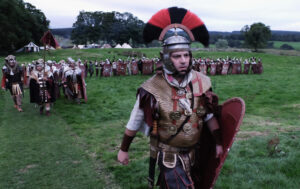Back in the early 2000s, when I was living in Moscow, I knew a Canadian who stomped around the city in a tartan kilt. When I asked him about his clan colours, he replied that he didn’t have any. His roots were German; he just liked wearing kilts.
In those days we didn’t worry about cultural appropriation. But now I can’t help but think of one academic’s objection to Nancy Pelosi posing in a traditional Ghanaian fabric as a tribute to George Floyd: “My ancestors did not invent Kente cloth for them to be worn by publicity (obsessed) politicians as ‘activism’ in 2020.” But what if you’re wearing someone else’s national dress just because you like the pretty pattern? Is that worse? Does tartan not count, because Scots are too ‘privileged’?
Regardless, back in the day it never occurred to me to wonder whether my ancestors would have approved of the kilted Canadian. Now, I suspect that they wouldn’t have given a shit.
I certainly didn’t. But perhaps I was relaxed about the pseudo-Scotsman because I knew that the whole “ancient tradition” of clan tartans was itself a fiction. I still remember the shock and disbelief I felt 30 years ago, when one of my lecturers at the University of Edinburgh explained that Walter Scott had cooked it up for a pageant celebrating King George IV’s visit to Scotland in 1822. Having been raised in the myth myself, it seemed incredible that so fundamental a symbol of Scotland could be at once so recent, and so fake. It being St Andrew’s Day today, the story bears retelling.
George IV was the first British king to travel north of the border in almost 200 years. At the time, the Edinburgh-born Scott’s historical novels were bestsellers, and the monarch was a fan. So, Scott was tasked with making him feel welcome. But the festival he organised owed far more to his imagination than historic reality. In it, representatives of Scottish clans cosplayed as highlanders — wearing their supposedly traditional and unique clan tartans.
Scott didn’t make it all up out of nothing, of course. Highlanders had worn tartan, and there were regional variations, but not a strict family taxonomy. And following the decisive defeat of Bonnie Prince Charlie’s highlander army at the Battle of Culloden in 1746, tartan was banned for 40 years. By the time the ban was lifted, highlanders had got used to wearing the same kind of clothes that lowland Scots wore, which were very similar to the kind of clothes that English people wore.
Nostalgia for the past remained, however. But it was commerce that revived tartan. In the early 19th century, a family of entrepreneurial merchant weavers in Edinburgh started a successful business matching tartans to clans, reinventing old designs or offering entirely new ones for “chieftains”. Scott dialled this polite fiction up to 11 — and tartan was established as one of the ultra-symbols of Scotland.
Some baulked at the artifice of it all. One Edinburgh resident complained that Scott had “ridiculously made us appear to be a nation of Highlanders, and the bagpipe and the tartan are the order of the day”. His own son-in-law referred to it as a “hallucination”. But many embraced Scott’s romantic retconning of history. The king himself was delighted to claim his Scottish roots, and strut about in a Royal Stuart tartan mini-kilt and pink tights. Lowlanders began dressing in the colours of imaginary highlanders and the tartan biscuit tin was born. Two decades later, Queen Victoria’s German consort Prince Albert decked out Balmoral as a kitsch Celtic fantasia and designed his own tartan.
Since the days of Scott, tartan has been inextricably bound with a desire to sell Scotland to the rest of the world. Walk down Edinburgh’s Royal Mile today and you will see tartan scarves, tartan skirts, tartan cardigans, tartan shortbread tins, tartan bonnets and, of course, tartan kilts. The target audience for this abundance of tradition is not local; it is the visitor looking to take something “authentic” home. If a Scot wears tartan, more likely than not it’s for a wedding.
And yet, when Scots emigrate abroad, it is Scott’s “hallucination” that endures after all memory of the homeland has faded. A 14” x 14” square of tartan made it to the moon three years before The Bible did because astronaut Alan Bean, whose Scottish ancestor had left the motherland in the mid-17th century, took a sample of the Clan MacBean for a spin in his Lunar Excursion Module in 1969. North Carolina’s Scottish Tartans Museum, in business since 1988, recently celebrated a 20-year extension on its lease. And while the Highland Games in Salado, Texas, can be a confused and confusing affair — I recall getting mildly irritated at all the songs about Irish whiskey and fields of emerald green — the Farquhars and the Colquhouns certainly knew their tartans, as did all the other representatives of the clans, proud standard bearers of an ancient tradition that dates all the way back to 50 years after the US itself was invented.
Personally, I prefer it when Americans invent their own tartans, with no connection to Scott’s highlander mythology whatsoever. These days, 27 states have their own tartan, including Texas, California, Hawaii and Rhode Island. USA Kilts (est. 2003) offer the American Dream tartan, which features 76 blue threads for the year 1776, 13 red stripes for the original colonies and a gold stripe as a reference to the “golden door” mentioned in the poem at the base of the Statue of Liberty.
An exhibition currently running at the V&A in Dundee highlights just how fluid tartan can be. On display are 300 exhibits from around the world, selected to demonstrate that the grid design is “open to infinite possibility”. Tartan, says the museum curator Mhairi Maxwell, is “a global phenomenon, expressing diverse ideas of belonging, kinship, nationalism, unity and resistance”. Indeed, it periodically slips loose of its moorings and acquires new meanings. When punks adopted tartan as an anti-establishment symbol in the Seventies, it was not the highland clearances that they were railing against. When Japanese schoolgirls wear short tartan skirts, they are not evoking the spirit of Bonnie Prince Charlie and the Jacobite rebellion.
In Scotland, too, people continue to invent tartans, now free of clan-connections. Recent years have seen a flourishing of designs. There is a Sikh tartan, commissioned by Gary Singh, a licensed grocer from Edinburgh. Since 2020 we have been blessed with not one but two tartans dedicated to climate change — the Climate Emergency tartan and COP26 — A New Dawn. In 2017, the Hunter Foundation commissioned the Obama Family tartan to commemorate the celebrated podcaster’s golfing holiday in Saint Andrews. The year before that, the Russian Consulate in Edinburgh commissioned the rather more sombre Second World War-themed Russian Arctic Convoy tartan, though whether anyone is likely to wear it in the current political climate seems doubtful. There is also a “Homeless” tartan to promote the plight of homeless people, and a Trump tartan which was designed to decorate the Trump International Golf Links in Aberdeenshire.
Tartan is not the only national signifier that frequently becomes detached from what it once signified. The Union Jack exists both as national flag and as global style icon, and its latter status owes much more to the music, films and fashions of the Sixties than it does to King James VI’s design sense. The Guy Fawkes mask transcended its historic origins through V for Vendetta, and has since become a free-floating symbol of revolt (with Warner Brothers collecting a royalty for each mask sold). And of course, there are countless other, non-British examples. Russian matryoshka dolls originated in Japan, while Mexico City’s Day of the Dead parade was inspired by a scene in a James Bond film. Entire national cultures were confected by Stalin and imposed upon Central Asia. Today, the successor states decide which bits of those Soviet identities they wish to keep, and which to discard.
Though unusually flexible, tartan is therefore typical of national symbols. Sir Walter Scott’s vision of Scottish tradition may have been a hallucination, but what do you call a hallucination when it lasts for two centuries and engulfs the world, evolving along the way? This Saint Andrew’s Day, I propose that we recognise him as the patron saint of culture-as-hallucination, of high artifice and symbolic mutability. Let the example of tartan demonstrate an alternative, better pathway for those who would seek to ring fence “tradition” and put a “private property” sign on culture. That approach leads to the smallness of the biscuit tin, and the prison house of “heritage”. A robust culture is attained through fantasy, through making things up — and continuing to make things up.
Disclaimer
Some of the posts we share are controversial and we do not necessarily agree with them in the whole extend. Sometimes we agree with the content or part of it but we do not agree with the narration or language. Nevertheless we find them somehow interesting, valuable and/or informative or we share them, because we strongly believe in freedom of speech, free press and journalism. We strongly encourage you to have a critical approach to all the content, do your own research and analysis to build your own opinion.
We would be glad to have your feedback.
Source: UnHerd Read the original article here: https://unherd.com/




